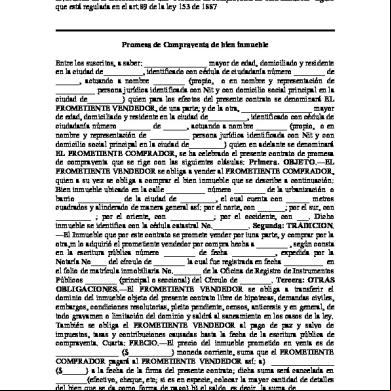Lecture-5-nozzles-and-diffs.pdf 334p3z
This document was ed by and they confirmed that they have the permission to share it. If you are author or own the copyright of this book, please report to us by using this report form. Report 3i3n4
Overview 26281t
& View Lecture-5-nozzles-and-diffs.pdf as PDF for free.
More details 6y5l6z
- Words: 417
- Pages: 18
Adiabatic flow through nozzles
But the actual process is irreversible adiabatic. Since the shaft work is absent the stagnation enthalpy remains constant (h01=h02).
The actual velocity c2 is less tan than the isentropic velocity. Also irreversible adiabatic flow experiences an increase in entropy ∆s and decrease in the stagnation pressure ∆p0= p01 – p02
Nozzle efficiency for large pressure ratio
The function of nozzle is to transform the energy of the expanding gas in to KE. Nozzle efficiency should be a measure of he energy transformation
We have
(7)
Nozzle Velocity coefficient
Most of the applications the gas or steam enters the nozzle from a large space. So the enthalpy at the beginning of the process is considered as h01 instead of h1
We have
Nozzle efficiency for small pressure ratio
From eqn. (7) we have
(h2-h2s) is the enthalpy loss due to irreversible flow For isentropic process we have
=0
If the change in pressure is small, the flow can be considered as incompressible (ρ = constant).
Adiabatic flow through diffs
The transformation of KE of gases in to a static pressure rise takes place in a diff
There is no change in entropy and loss in stagnation pressure during a reversible adiabatic pressure.
But actual process is irreversible adiabatic, it must be accompanied by a stagnation pressure loss and increase in entropy. Final state after irreversible adiabatic process is represented by point 2. This is fixed by assuming same change in the KE.
There will be a change in static pressure but the stagnation enthalpy remains the same
Diff efficiency for small pressure rise
For small rise in static pressure, the flow in the diff can be considered as incompressible (ρ ≈ constant)
Therefore the pressure rise is given by
For the actual state point 2
Therefore the pressure rise in actual process is given by
But
Thus we have
Diff efficiency
But we have
Diff efficiency for large pressure rise
For large pressure rise through turbines, density change is appreciable and flow is compressible
We have the energy equation for the processes
Substituting this in to the efficiency equation we have
For incompressible flow this expression can be reduced to expressions derived for small pressure rise. For example
Therefore we have
This is same as the expression that derived for small pressure rise.
But the actual process is irreversible adiabatic. Since the shaft work is absent the stagnation enthalpy remains constant (h01=h02).
The actual velocity c2 is less tan than the isentropic velocity. Also irreversible adiabatic flow experiences an increase in entropy ∆s and decrease in the stagnation pressure ∆p0= p01 – p02
Nozzle efficiency for large pressure ratio
The function of nozzle is to transform the energy of the expanding gas in to KE. Nozzle efficiency should be a measure of he energy transformation
We have
(7)
Nozzle Velocity coefficient
Most of the applications the gas or steam enters the nozzle from a large space. So the enthalpy at the beginning of the process is considered as h01 instead of h1
We have
Nozzle efficiency for small pressure ratio
From eqn. (7) we have
(h2-h2s) is the enthalpy loss due to irreversible flow For isentropic process we have
=0
If the change in pressure is small, the flow can be considered as incompressible (ρ = constant).
Adiabatic flow through diffs
The transformation of KE of gases in to a static pressure rise takes place in a diff
There is no change in entropy and loss in stagnation pressure during a reversible adiabatic pressure.
But actual process is irreversible adiabatic, it must be accompanied by a stagnation pressure loss and increase in entropy. Final state after irreversible adiabatic process is represented by point 2. This is fixed by assuming same change in the KE.
There will be a change in static pressure but the stagnation enthalpy remains the same
Diff efficiency for small pressure rise
For small rise in static pressure, the flow in the diff can be considered as incompressible (ρ ≈ constant)
Therefore the pressure rise is given by
For the actual state point 2
Therefore the pressure rise in actual process is given by
But
Thus we have
Diff efficiency
But we have
Diff efficiency for large pressure rise
For large pressure rise through turbines, density change is appreciable and flow is compressible
We have the energy equation for the processes
Substituting this in to the efficiency equation we have
For incompressible flow this expression can be reduced to expressions derived for small pressure rise. For example
Therefore we have
This is same as the expression that derived for small pressure rise.





